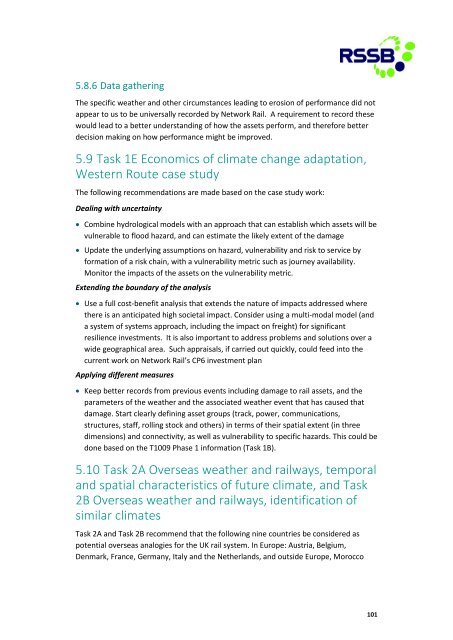Tomorrow's Railway and Climate Change Adaptation Final Report
2016-05-T1009-final-report
2016-05-T1009-final-report
You also want an ePaper? Increase the reach of your titles
YUMPU automatically turns print PDFs into web optimized ePapers that Google loves.
5.8.6 Data gathering<br />
The specific weather <strong>and</strong> other circumstances leading to erosion of performance did not<br />
appear to us to be universally recorded by Network Rail. A requirement to record these<br />
would lead to a better underst<strong>and</strong>ing of how the assets perform, <strong>and</strong> therefore better<br />
decision making on how performance might be improved.<br />
5.9 Task 1E Economics of climate change adaptation,<br />
Western Route case study<br />
The following recommendations are made based on the case study work:<br />
Dealing with uncertainty<br />
• Combine hydrological models with an approach that can establish which assets will be<br />
vulnerable to flood hazard, <strong>and</strong> can estimate the likely extent of the damage<br />
• Update the underlying assumptions on hazard, vulnerability <strong>and</strong> risk to service by<br />
formation of a risk chain, with a vulnerability metric such as journey availability.<br />
Monitor the impacts of the assets on the vulnerability metric.<br />
Extending the boundary of the analysis<br />
• Use a full cost-benefit analysis that extends the nature of impacts addressed where<br />
there is an anticipated high societal impact. Consider using a multi-modal model (<strong>and</strong><br />
a system of systems approach, including the impact on freight) for significant<br />
resilience investments. It is also important to address problems <strong>and</strong> solutions over a<br />
wide geographical area. Such appraisals, if carried out quickly, could feed into the<br />
current work on Network Rail’s CP6 investment plan<br />
Applying different measures<br />
• Keep better records from previous events including damage to rail assets, <strong>and</strong> the<br />
parameters of the weather <strong>and</strong> the associated weather event that has caused that<br />
damage. Start clearly defining asset groups (track, power, communications,<br />
structures, staff, rolling stock <strong>and</strong> others) in terms of their spatial extent (in three<br />
dimensions) <strong>and</strong> connectivity, as well as vulnerability to specific hazards. This could be<br />
done based on the T1009 Phase 1 information (Task 1B).<br />
5.10 Task 2A Overseas weather <strong>and</strong> railways, temporal<br />
<strong>and</strong> spatial characteristics of future climate, <strong>and</strong> Task<br />
2B Overseas weather <strong>and</strong> railways, identification of<br />
similar climates<br />
Task 2A <strong>and</strong> Task 2B recommend that the following nine countries be considered as<br />
potential overseas analogies for the UK rail system. In Europe: Austria, Belgium,<br />
Denmark, France, Germany, Italy <strong>and</strong> the Netherl<strong>and</strong>s, <strong>and</strong> outside Europe, Morocco<br />
101


